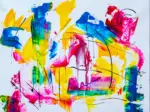Art is weird.
As creatives, artists are expected to express their visions in an original, nuanced way, yet also adhere to the fluid and nondescript tastes of the public. The concept of displaying one’s finest work only to receive distaste in reply is a fear so haunting that many refuse to even approach the spotlight’s glow. Creation is hard, criticism easy.
And yet, to make art is to accept its subjectivity. The beauty of a work is within the eye of its beholder — so too are its indiscretions. To depart from the standard is, ultimately, to subject oneself to the very real prospect of rejection. Purists scoff at the deviation from age-old tradition, and yet evolution is the only way art can continue to exist.
Art adapts to its environment, as people do. Art is change.
Nothing justifies this philosophy quite like the rise of doll customization. Doll-making as an art can be traced back thousands of years. Some of the oldest artifacts ever found are thought to have been used as dolls or small totems. People have, it seems, long enjoyed creating figures similar to themselves and the creatures they saw around them. The popularity of this toy makes its mass-scale manufacturing and sale easy. In 2020, popular Mattel toy line Barbie boasted a total of $1.35 billion dollars in its most successful fiscal year since 2017.
Some find that the mass, and often cheap, production of these dolls, however, leaves much to be desired. Dolls are enrapturing not only to a young audience, but also to a flourishing community of collectors and artists as well.
Such a development is not necessarily unsurprising. The wide variety of dolls demonstrating the vastness of artistic style and the sheer number of dolls available would certainly be draws for collectors. But what about artists? Why might they have taken such an interest in the seemingly arbitrary world of dolls? Why aren’t they satisfied? And what is doll customization, anyways?
As its title might suggest, doll customization entails the revision of a doll, usually factory pre-made, in whatever way the creator sees fit. This can include re-painting the doll and picking or even tailoring tiny clothes for it. These tasks can prove arduous due to their required precision, seeing as the surface area of a doll is usually very small. Hundreds of hours of work can go into completing a single doll, although the process is different for each artist.
These creators showcase their works through online mediums such as Instagram and YouTube. With some good fortune, many of these artists have gained a sizeable following — and it’s understandable why. Documenting the creative method that goes into styling the dolls makes for not just an entertaining watch, but a valuable insight into the meticulous process the practice entails. This insight is inspiring to other creatives of all kinds, as well as to anyone who simply wants to learn more about the niche community of doll customization.
Within this sphere, there are artists who are respected as veterans of their craft. Korean YouTuber Dollightful is one of the most popular within the doll customization community, and for good reason. In her videos, she details the in-depth process she uses to create her dolls, and uses her platform to create a welcoming atmosphere that engages even those who know very little about the art. The Dollightful channel now boasts an impressive 1.7 million subscribers, and its creator, Katherine, has produced well over a hundred unique and colorful dolls.
https://www.instagram.com/p/CQhhladhZaH/
Her process is thoughtful, and indicative of the ideas that go into many different doll customizers’ projects. Generally starting with concept sketches, an artist then chooses a store-bought doll and strips it down to its bare essentials, removing the factory paint from its face and cutting off any hair. To someone unfamiliar with the process, this procedure can look comical. It’s strange to see a child’s doll without any of its defining features, and this really exemplifies the manufactured nature of the doll. The process is distinctly artistic — the blank canvas of a newly clean doll smells like potential.
From there, any number of things can happen.
Giving a doll a brand new hairdo can be a time-consuming process. There are different methods by which one might go about it — some creators like to make wigs for their dolls, so they can be easily removed and switched out. Others give their dolls a whole new head of hair by plugging small bunches of doll hair into the doll’s scalp one by one.
Giving a doll a new face is one of the most memorable qualities of doll customization. Most store-bought dolls’ faces are created using silicone molds, so many artists use the pre-made lines of the eyes, nose and lips to guide their hand. Artists typically use tools such as colored pencils, paints and pastels to give the doll a face-up. The result demonstrates the amount of love and care taken to create a detailed drawing on such a small and uneven surface.
Of course, no doll is complete without its own wardrobe. Through trial and error, doll customizers design and produce little clothes of every kind, from jackets to dresses to handbags. The process is similar to creating clothes for a full-sized human, albeit on a much smaller scale. In this way, doll customizers must be multi-faceted: drawing, design, sculpting and even tailoring skills are all part of a well-rounded doll.
The diverse nature of doll customization makes perusing through the works of different artists a real delight. Dozens of artists have made a name for themselves from doll customization alone, proving not only the versatility of the art, but also its appeal to a wide audience. Each creator employs their own recognizable tastes and style — Poppen Atelier is characterized by her creations’ delicate, fairylike features and ornate outfits, for instance, while HeXtian’s distinct drawing style and glamorous aesthetic are instantly striking and distinct.
https://www.instagram.com/p/BzBgHsYj6Nw/
How would one enter the doll customization hobby? Despite its seeming complexities, the materials needed to customize a doll don’t have to be extravagant. With a base doll, some spare fabric, and a few paints or color pencils, one has a solid foundation to learn the basics. To make higher quality products, however, it may be helpful to invest in higher quality and specialized materials, such as hair made specifically for dolls.
The process of doll customization is unlike anything else. There’s something poetic about recycling a nondescript toy into a work of art created with purpose and care. This customization is, in a way, an evolution of the art of toymaking. It is a discipline that demands respect, a mature spin on a child’s whimsy. Mass production, it seems, doesn’t entail the death of dollmaking — rather, it now takes on a new form.
Art is weird, and art is change. It adapts to its environment, and it is truly a spectacular thing to watch, if you take the time to appreciate it.

















